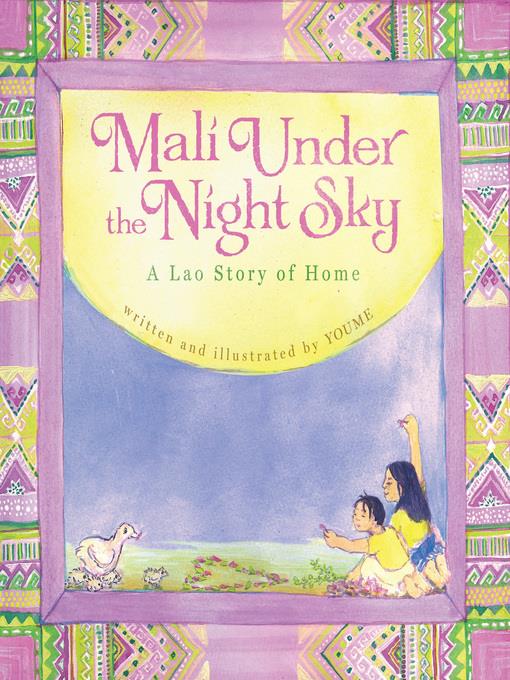
Mali Under the Night Sky
A Lao Story of Home
فرمت کتاب
ebook
تاریخ انتشار
2010
Lexile Score
640
Reading Level
2-3
ATOS
3.9
Interest Level
K-3(LG)
نویسنده
Youme Landowneناشر
Cinco Puntos Pressشابک
9781935955191
کتاب های مرتبط
- اطلاعات
- نقد و بررسی
- دیدگاه کاربران
نقد و بررسی

November 22, 2010
A Laotian girl's life takes a cruel turn in this haunting yet hopeful tale based on the childhood of Laotian-American artist Malichansouk Kouanchao. Sunny watercolors with patterned borders illuminate the simple joys of Mali's early life, when the world was "full of wonderful things." She climbs trees, helps prepare feasts, and participates in the tradition of tying strings around the wrists of family and friends, "a way of showing that their hearts would always be together." The palette darkens as change—described only vaguely—comes to Laos ("Fighting in neighboring countries was bringing danger to the land and the people"). Young readers may not understand why Mali's family is arrested "for not having a home" and placed in a crowded jail with other refugees after they flee to a neighboring country (afterwords from Kouanchao and a Laotian writer/filmmaker provide more context). There, the strings circling her wrist inspire Mali to share memories of her homeland to lift the spirits of fellow prisoners. Landowne (Sélavi: A Haitian Story of Hope) smoothly includes several Laotian words and phrases in this deeply felt and gently told story. Ages 5–10.

October 1, 2010
Malichansouk Kouanchao is a Laotian-American artist, but once upon a time she was a child living through difficult times. Her life seemed idyllic, portrayed in spring-hued watercolors surrounded by intricately designed borders. The simple text describes the little girl playing in rice paddies, cooking spicy food and attending weddings, where the custom was to tie ceremonial strings around relatives' wrists to seal familial love. Then the story and the paintings grow darker. The Lao people endured civil war and American bombings, and many faced political persecution, though the text does not explicitly say why or when Mali's family fled. Lao words are sprinkled throughout the text, almost as a poetic refrain, and these words in Lao script appear in dialogue bubbles in the corresponding double-page spreads. In a unique touch, the Lao numbers appear on each page. This biographical account is presented as a story rather than as a piece of nonfiction, and as such, it's not quite as compelling as it might have been with more specific details. A note from Mali and an essay by Thavisouk Phrasavath at the end help provide some context. (Picture book. 4-7)
(COPYRIGHT (2010) KIRKUS REVIEWS/NIELSEN BUSINESS MEDIA, INC. ALL RIGHTS RESERVED.)

November 1, 2010
Gr 1-4-This story of a life disrupted by war is told in a simple, straightforward manner, from a child's point of view. Mali loves her country: the markets, rice fields, bamboo forests, and the tradition of tying strings around the wrists of loved ones to show that their hearts are together. This element ties together the two halves of the book: the tradition is introduced in the happy setting of weddings and family gatherings, but then Mali receives strings before her family is put in jail, and they become an important symbol "that tied her to her beautiful home." While in prison, the child raises the spirits of her fellow captives with memories of home. Politics are not addressed, and there is no good/evil dichotomy. The focus remains tightly on Mali's experiences and feelings, keeping it accessible to young readers. An endnote introduces the real Mali, Malichansouk Kouanchao, an artist upon whose experiences the book is based, and an additional endnote by another Laotian artist provides historical context. Laotian vocabulary is incorporated in a natural way, and the illustrations include Laotian script. The watercolor illustrations, while naive in style, convey a real sense of place. Intricate borders surround every spread, and the bright/dark color schemes reflect the emotions of each scene. The book will be best appreciated by children when read with an adult to help them process the troubling elements of Mali's life. While not a fun story, it is an important well-told one.-Heidi Estrin, Feldman Children's Library at Congregation B'nai Israel, Boca Raton, FL
Copyright 2010 School Library Journal, LLC Used with permission.

January 1, 2011
Preschool-G With a spare first-person narrative and affecting watercolor-wash illustrations, this biography by the author of S'lavi, That Is Life: A Haitian Story of Hope (2004) tells of a familys escape from civil war in Laos. The opening images celebrate family roots with pictures of a young girl, Mali, playing safely in a forest, in her community, and at home. A glowing spread framed with traditional patterns shows the custom of tying strings around loved ones wrists at festivals and partings to celebrate always being together. In abrupt contrast, the images move to scenes of Mali alone on a tense, empty street. War is near, and the family flees at night across a wide river to another country, where they are arrested for not having a home. A view of the family behind bars in a crowded jail is juxtaposed with a double-page close-up of the strings around Malis wrist as she remembers her rich connections. The small childs viewpoint will move young readers, and a final photo shows the real Mali, an artist and activist, today.(Reprinted with permission of Booklist, copyright 2011, American Library Association.)

























دیدگاه کاربران